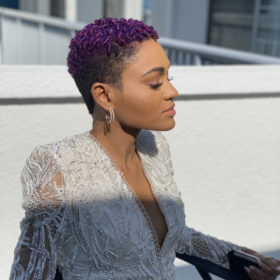This Disability-Rights Crusader’s Hair has Become her Calling Card
Bleached blond, red, purple… When it comes to Lauren “Lolo” Spencer’s hair, her cropped curls are her ever-evolving playground. “I love my hair because I switch it up all the time,” says the Los Angeles-born and-bred actress, model and disability-rights advocate. “Once you go completely Amber Rose buzz-cut bald, you’re just not afraid to try anything else after that.”
She visits her hairstylist (who happens to be her best friend) every four to six months for her transformational dye jobs and reaches for Overtone, a line of pigment-depositing conditioners, to help replenish her new hues in between. “I keep my hair conditioned as much as possible without overdoing it,” she says.
Spencer’s chameleonic ’do has also become her unexpected trademark. “I’ve never dyed my hair on purpose for attention,” she says. “But I do know that my audience is growing and that my hair colour plays a role in how people remember me: I’m always the girl in the wheelchair with the purple hair or something like that.” Overly vague description aside, she’ll take it. “I’m not mad at all; it has worked in my favour.”

The audience Spencer is referring to is the 12,000+ YouTube subscribers (and over 20K followers on Instagram) whom she has amassed on her channel “Sitting Pretty,” which she started in 2015 to showcase what her life is like as a physically disabled woman. At 14, Spencer was diagnosed with the progressive neurodegenerative disease ALS. By 19, she was using a wheelchair to get around. With video topics ranging from fashion tutorials to dating to life’s everyday challenges, the 32-year-old’s vlog is a bright-toned act of self-love fuelled by the ultimate goal of dispelling society’s narrow views of people with disabilities.
And just like her daring, multi-tinted approach to her hair and deep desire to “represent disability in a fun, fly and sexy way,” Spencer’s sartorial ways are also something to be admired. “My style really reflects my extroverted personality,” she says. “I like to keep it very ‘what I’m about.’ I’m about my culture: hip-hop culture, Black culture—everything. My style is a blend of that and being sexy and wearing stuff that is completely unexpected: colour, texture, patterns—anything that pushes the envelope.”

Spencer wasn’t always so outgoing with her fashion choices, she admits. “Before, I was like, ‘If it’s not black, white or grey, I don’t want to wear it.’” Then she met Stephanie Thomas, a fashion stylist who specializes in dressing people with disabilities. “She influenced me entirely,” she says. “She taught me how to look for pieces that will work with my seated body type, which I never knew how to do prior to meeting her.” Some of Thomas’s stylist-recommended tips include high-waisted bottoms to prevent Spencer from having the unsightly “plumber’s crack” while seated and shoulder accents to complement her unique curves due to scoliosis. “Anything that gives off the illusion that my shoulders are straight,” she explains. “Whenever we talk, we’re always like, ‘OK, what is something the public hasn’t seen people with disabilities wear before?’”
Since 2018, the fashion maven has been able to channel her love of style, activism and colourful hair into fashion campaigns for big-name brands like Tommy Hilfiger and St. John knitwear. Her favourite thus far? Modelling in the Tommy x Zendaya Fall 2019 capsule collection, an extensive ’70s-inspired assortment in which 10 styles featured adaptive modifications. The shot of a purple-headed Spencer wearing a houndstooth trench coat and knee-high leather boots is a style moment she’ll never forget. “When I saw it, I was like, ‘Oh, my God, that’s me!’ It’s such a powerful image. I’m dressed phenomenally and my head is held high. It’s like it’s saying ‘I’m here!’”

And whether she’s fronting a YouTube video or a fashion campaign or she’s on the big screen (Spencer starred in her very first film, Give Me Liberty, last year), the self-described disability-lifestyle influencer brings a breath of much-needed fresh air and an important message: that her voice—and voices like hers—is valid and has the right to take up space. “Each demographic that I represent is a minority: disabled, Black and a woman,” she says. “Society has created a world that has never really appreciated or respected any of those three in their entirety. We’re just now starting to see some change, and that’s the part I’m excited about.”
The post This Disability-Rights Crusader’s Hair has Become her Calling Card appeared first on FASHION Magazine.